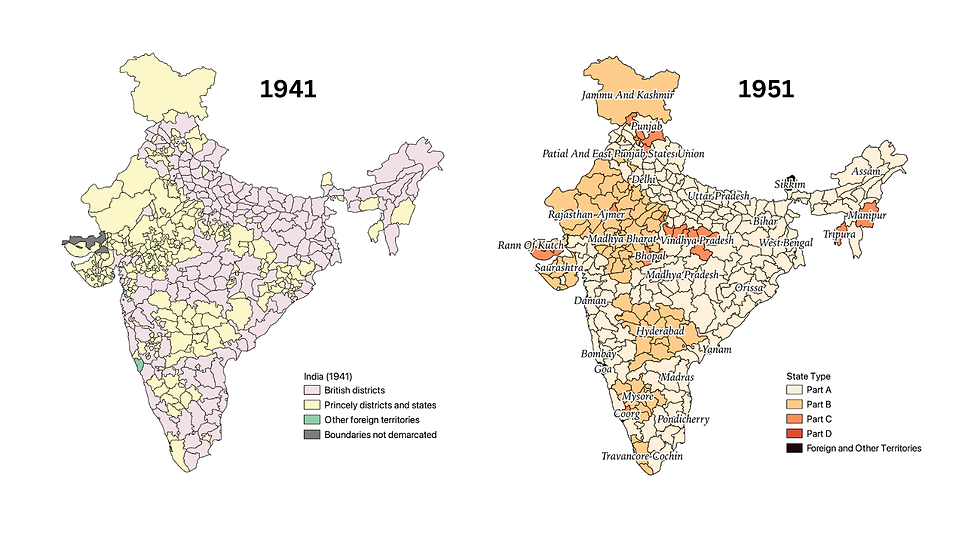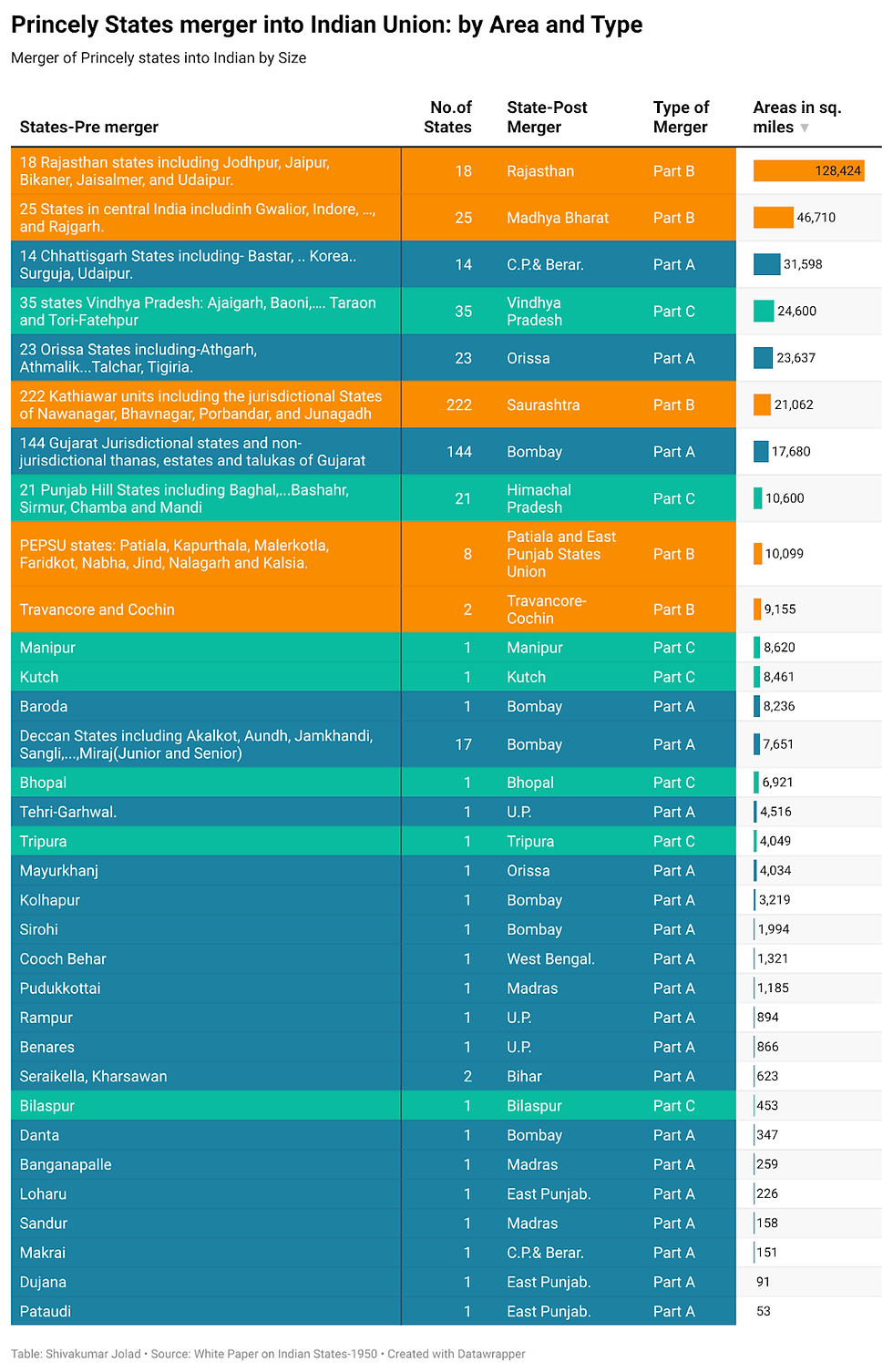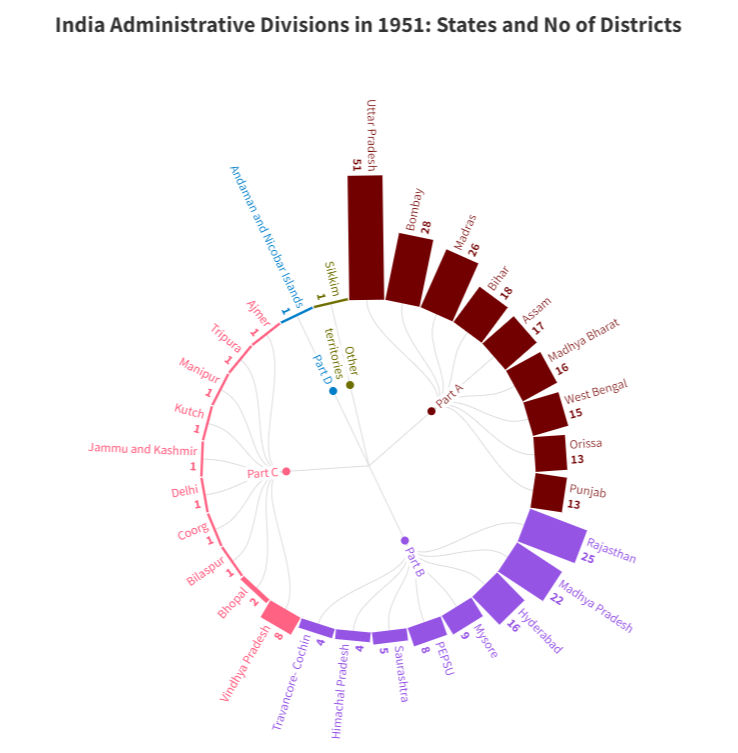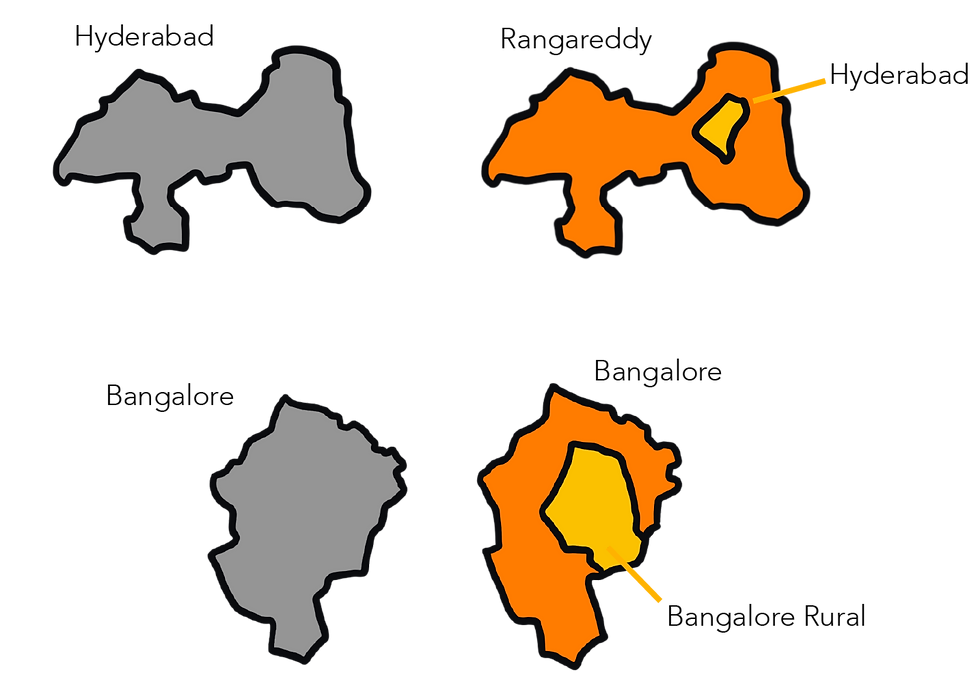3 | Post Independence District Consolidation - between 1947-1951
- indiastatestories
- Aug 3
- 4 min read
Updated: Aug 20

India inherited 550 plus princely states, most of which merged into the new Indian Dominion after the independence in 1947. After the lapse of British Paramountcy, some merged into centrally administered areas, some were integrated with existing provinces, and others were amalgamated to form bigger administrative units.
Merger with provinces – States geographically contiguous to provinces were merged into them. Constitutionally, they were treated as part and parcel of the provinces.
Centrally administered areas – Some States were taken over individually or as groups and administered by the Central Government as Chief Commissioners' Provinces. They came under the direct control of the new Government of India.
Unions of States – Territories of multiple States were integrated to create new viable units. Covenants were drafted for the formation of these unions. (Menon, 1956)
Status of French and Portuguese territories remained unchanged and were not integrated into India.
The new Constitution of India classified these new administrative units into Part A (former Governor's Provinces), Part B (Unions, Hyderabad, Mysore, Jammu and Kashmir), and Part C States (former Chief Commissioners' Provinces). This restructuring revealed stark contrasts in administrative maturity, with advanced states like Mysore, Travancore, Hyderabad having sophisticated systems, while smaller states lacked basic infrastructure. The integration process involved creating uniform administrative structures, standardizing revenue and judicial systems, and addressing personnel shortages. Districts emerged as key administrative units during this process. Modern day federal tensions can be traced back, in part, to this period of administrative integration.

The Census publication ‘A Historical Perspective of Evolution of Districts and States in India. Registrar General of India’ by Singh 2004, records the comprehensive changes in the administrative reorganization. They are summarized as follows:
Assam State: Boundary affected by partition between India and Pakistan. Part of Sylhet transferred to East Pakistan, part merged in Cachar. United Khasi & Jaintia Hills district formed. New district United Mikir & North Cachar Hills created from Cachar. North East Frontier Agency (NEFA) became a new division with four districts (Balipara, Abor Hills, Mishmi Hills, Tirap Frontier Tract). British district Naga Hills merged into New Naga Tribal Areas (Naga Hills and Tuensang).
Manipur and Tripura: Former Princely states of Manipur and Tripura (of Assam and West Bengal respectively) constituted as independent administrative units in the Indian Union.
West Bengal: Cooch Behar Princely state became one of its districts. Dinajpur renamed West Dinajpur.
Bihar: Manbhum renamed Purulia, which was then bifurcated into Dhanbad and Purulia. Saharsa was created from Bhagalpur.
Uttar Pradesh: Formed from 48 British districts. Tehri Garhwal and Rampur Princely states merged. Benares Princely state merged with Benares district. Gorakhpur bifurcated to form Deoria. Total districts rose to 51.
Bilaspur: Taken over as a centrally administered territory due to Bhakra Dam. It maintained this this distinct centrally administered status for several years.
Delhi: Designation changed to uni-district Delhi State from Delhi Province.
Punjab Province: Boundaries affected by partition. Gurdaspur divided, Amritsar gained part of Kasur tahsil from Lahore. Princely states Dujana, Pataudi, Khalsia merged in Ludhiana, Rohtak, Ambala. Hissar gained parts of Nabha, Patiala, Jind. Remaining parts of Nabha, Patiala, Jind transferred to newly formed Patiala and East Punjab State Union (PEPSU), which had eight districts.
Himachal Pradesh: New creation with four districts: Chamba, Mandi, Mahasu, Sirmoor, created from territories of Princely state Punjab. Bashahr Princely state was renamed Mahasu.
Rajasthan State: Began consolidation after independence, forming 25 districts by 1951. Palanpur and Danta Princely states amalgamated with Bombay. Part of Sirohi Princely state and Abu merged with Bombay.
Madhya Pradesh State: Central Province and Berar renamed Madhya Pradesh. Bastar and Kanker Princely states formed one district (Bastar). Raigarh, Sarangarh, Sakti, Udaipur, Jashpur formed Raigarh district. Korea, Chang Bhakar, Surguja merged to form Surguja district. Makrai merged with Hoshangabad. Chhuikhadan, Nandgaon, part of Khairagarh transferred to Durg. Kawardha and the remaining Khairagarh added to Bilaspur. Total 22 districts.
Central India Agency Bifurcated: Formed three independent states: Madhya Bharat, Bhopal, and
Vindhya Pradesh.
Bhopal became a State, divided into Raisen and Sehore districts.
Vindhya Pradesh formed from 17 Princely states, constituting eight districts.
Madhya Bharat consolidated remaining Princely states, with 16 reconstituted districts.
Bombay State: Renamed Bombay. Gained Idar, Sabarkantha Agency, and other Princely states from Western India State Agency and Rajputana Agency, and merger of Baroda.
Kutch: Merged into Indian Union in 1948 as a separate state with one district.
Saurashtra State: Remaining 33 Princely states of Western India State Agency merged to form Saurashtra, divided into five districts.
Travancore-Cochin State: Formed in 1949 by integration of Travancore and Cochin. Areas added from Madras, some enclaves lost to Madras. Travancore had Trivandrum, Quilon, Kottayam. Integration added Trichur as fourth district.
Madras State: Princely states Pudukkottai, Sandur, Banganapalle merged with Tiruchirapalli, Bellary, Kurnool. Changes in Malabar and Tirunelveli boundaries due to Travancore-Cochin formation. Pockets of Malabar and South Kanara in Laccadive, Minocy and Amindivi Islands area. Vizagapatam bifurcated into Srikakulam and Vizagapatam. Godavari West, Godavari East, Ramnad, Trichinopoly renamed West Godavari, East Godavari, Ramanathapuram, Tiruchirapalli.
Orissa State: Six British districts and 26 Princely states merged to form 13 districts.
Hyderabad State: Minor territorial changes with Bombay. Nander renamed Nanded. Baghat and Atrai-i-Balda Princely states merged into Medak and newly formed Hyderabad districts.
Coorg State: Became a uni-district state, recording Mercara district.
Mysore: Kadur Princely state renamed Chikmagalur district.
Andaman and Nicobar Islands: Came under direct Indian Government control.
This period was characterized by a rapid and significant redrawing of India's internal administrative map, driven by the political necessity of consolidating the newly independent nation and integrating the formerly autonomous Princely States.

The evolution of colonial administrative divisions into the districts in post-colonial India - 1941-1951
References
Government of India. (2011). Indian Administrative Atlas 1872-2011: Census of India 2011. Registrar General of India and Census Commissioner.
Menon, V. P. (1956). The Story of Integration of the Indian states. Orient Blackswan.
Singh, R. P., Banthia, J. K., & Commissioner I. O. of R.G. & C. (2004). India Administrative Atlas, 1872-2001: A Historical Perspective Of Evolution Of Districts And States In India. Registrar General of India.




Comments